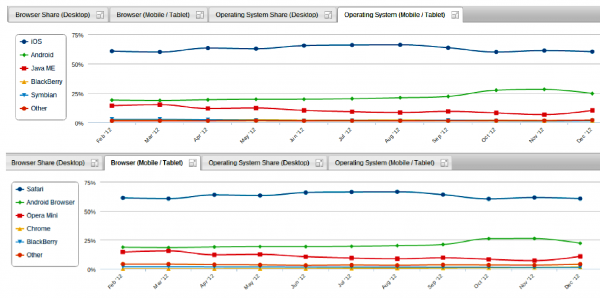Stupid bloggers misstate Windows 8 market share
Yesterday, Net Applications released usage share data for December, although the number is widely reported today as being market share. It's not. Already, several blogs pulled out Windows 8 and Internet Explorer 10 stats, and their writers and story commenters draw conclusions about the operating system's early adoption. They're wrong to do so, and you'd be wise not to believe them.
NetApps culls its data from browser usage, which often isn't synonymous with operating systems. High usage of one browser can skew the data, which it does for mobile operating systems. For example, the data shows that in December, iOS mobile OS share (on phones and tablets) was 60.56 percent compared to Android's 22.1 percent. But, whoa, the numbers are similar for the Apple and Android browsers -- 60.13 percent and 24.6 percent, respectively. A quick read of NetApps mobile OS share suggests iOS is more than twice Android. That's not the case based on data from Apple, Google and analyst firms like comscore, Gartner, IDC and IHS iSuppli.
Now consider that against cumulative Android shipments exceeding iOS (according to Google and Apple). At the least OS usage should be similar, if not greater for Android. However, based on other analyst data (and that from some mobile ad networks), iOS device owners browse the web more than their Android counterparts. That explains the operating system disparity and raises doubts about interpretations being made about IE10 and Windows 8 data.
NetApps puts Windows 8 usage share at 1.72 percent, which is considerably higher than the IE10 trend (0.96 percent). Windows RT is 0.01 percent, by the way, and that bodes poorly for Surface and competing tablets -- assuming the data is reliable enough to draw conclusions (it's not). Windows 8 usage share rose in December but that reveals nothing meaningful yet.
Consider this: In November overall Windows share fell to 91.45 percent from 91.63 percent the previous month. Meanwhile OS X rose to 7.3 percent from 7.16 percent during the same time period. December: 91.74 percent and 7.07 percent, respectively. So, what? Macs stole share from Windows PCs in November but gave it back in December? The long-term trend is OS X gaining against Windows, which, respectively, had 5.47 percent and 93.52 share in January 2011. Is there a reversal underway? A few more months of data will show something, while a month isn't enough.
But much will lack, because NetApps public data doesn't accurately show mobile OS data or indicate shifting platforms. For example, people using Windows PCs and Macs less and tablets more. The point: NetApps data is pretty good for discerning long-term trends. Don't bet the future (or even current state) of IE10 or Windows 8 based on one month's data. Nor regard usage share as market share. NetApps measures who uses what when. By contrast, market share is a measure of X widgets consumed over Y time frame. Got it?

